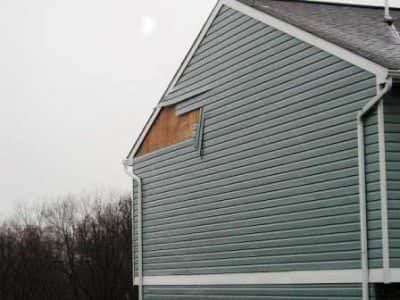For a very long time now, the most popular siding material in the United States has been vinyl. It is an excellent material, but it is worth remembering that there are solutions such as ACM Panels, wood siding and fiber cement. What material will work best for wall cladding your home? Is the ideal product? Let’s find out together!
What do you need to consider when choosing siding material?
At the very beginning, let’s enter some criteria that we will analyze. On our list are:
- Durabilty;
- Affordability;
- Ease of maintenance;
- Universality;
- Aesthetics.
Each material has its own advantages and disadvantages, so as a reputable siding contractor, we have tried to prepare as comprehensive a comparison as possible.
Vinyl Siding – reasonable solution

Let’s start with the most popular type of siding in residential construction, namely vinyl. According to statistics, more than 70% of homes in the north of the United States are covered with this material, and this is a most reasonable phenomenon. Traditional aesthetics, reasonable price/quality ratio, very wide availability and high weather resistance make vinyl simply a good siding material that works well in our latitude.
On the other hand, the popularity of vinyl siding does not overshadow its drawbacks – after all, it is a form of plastic that has nothing to do with naturalness. Some may associate this material with cheap construction, which should come as no surprise, after all, we are talking about a relatively affordable, yet very durable form of cladding. You also have to reckon with the risk of UV damage. Some vinyl sidings is very susceptible to the sun and can yellow or peel after time.
Pros of Vinyl Siding
Price is probably the biggest advantage of vinyl. Even if we searched for weeks, we would not find a cheaper option. At the same time, it is worth noting that the range of manufacturers is very wide, and you can easily buy premium products as well, often even much more expensive than other materials.
Durability is another very important feature. We often repair and replace siding installed in the early 21st century and even in the 1990s. If you choose the right quality product, your siding will last 20 or 30 years.

Ease of maintenance. A huge advantage of this siding material is its ease of maintenance – vinyl does not require regular impregnation, it does not rot, and you can even use a pressure washer to clean it, as long as you adjust its powers accordingly. This type of siding is dedicated to people who do not want to spend too much time or money on taking care of their home.
Cons of Vinyl Siding
Popularity. Although it’s hard to say that the popularity of this siding material is a clear disadvantage, some people may not be happy about it. If you are looking for uniqueness, vinyl is unlikely to be for you.

It’s a plastic. Vinyl is a plastic, which many people don’t like. This makes it possible for water to collect under the cladding, causing mold. If you take care of the proper quality of installation, you are unlikely to have to worry about such a problem, but we had to mention it.
Wood – Siding Material for Nature Lovers
Wood is certainly the most traditional natural siding material, which, despite its few drawbacks, has plenty of lovers. When it comes to Chicagoland houses, by far the most common choice of homeowners and designers is cedar. It’s a relatively expensive wood, but its good mechanical properties and unique appearance make it highly recommended. Redwood and fir are also interesting alternatives to cedar.
The undeniable advantage of cedar siding (as well as any other wood siding) is its natural character. Being sourced from trees, this form of wall cladding is much more neutral to the environment, plus, it does not emit harmful substances as it ages.
Pros od Wood Siding
Nothing looks as good as wood – the undoubted advantage of this siding material is its aesthetics. Whether you opt for cedar, sequoia, fir or any other wood, with proper maintenance, you can achieve a phenomenal visual effect.

Naturalness – more and more homeowners are paying attention to the origin of the materials used to build their house. By opting for wood siding, you can be sure that you are living in a nature-friendly place.
Good insulating properties – wood retains heat very well, so you will find it easier not only to heat, but also to cool your home. Although every wall can be equipped with a suitable thermal barrier, this siding material makes this task very easy.
Cons of Wood Siding
Wood requires regular maintenance – there is no other siding material so sensitive. For this reason, when deciding on cedar, fir, sequoia or any other wood, even with the best possible qualities, you must remember about proper protection. Go otherwise, after just a few years you will notice that the boards will begin to croak, crack and fade. With a little effort, you can adequately protect your siding, but it requires a certain amount of time and money.

Good wooden siding can be very expensive – this siding material can be really expensive – boards can cost 4, 5, even 6 times more than vinyl! Add to this the cost of installation, and you get a very aesthetically pleasing, but certainly not cheap solution. If you’re paying attention to your budget, cedar may not be the best choice, as its purchase and subsequent maintenance can put a huge strain on your pocket.
Fiber Cement – Siding Material for Demanding Ones

Fiber cement, also known as hardie plank, is a siding material consisting mainly of cement, cellulose fibers and sand. It owes its popularity to its very high resilience, aesthetics and high customizability. The plastics used to make fiber cement can withstand even years of exposure to snow, rain and UV radiation, making this material suitable for installation on homes located in Wheeling as well as Arizona. Fiber cement does not rot, is pest resistant and is non-flammable. Sounds good, right?
It is also worth noting that fiber cement siding is available in a variety of colors and patterns, allowing you to customize the appearance of the building to your aesthetic preferences – manufacturers are outdoing themselves in creating new patterns and colors. It is an easy-to-install material, which can translate into a quick replacement process and reduce its cost.
Unfortunately, nothing is perfect. Fiber cement siding is quite expensive – the price is much higher than that of vinyl, although it is further below that of cedar.
Pros of Fiber Cement Siding
Durability – fiber cement is an extremely durable siding material that will last up to 50 years. Resistant to UV radiation, water, fire and insects, you get peace of mind for many years when you opt for this form of cladding. That’s a huge advantage.
Ease of maintenance – as with vinyl, fiber cement maintenance is not rocket science. You don’t have to worry about waterproofing, and only clean the walls from time to time.

Huge possibilities for personalization – fiber cement is available in such a large number of variants and models that you are sure to find a product to your liking. James Hardie, the industry leader, has an extremely wide range of siding solutions.
Cons of Fiber Cement Siding
Price – fiber cement is a rather expensive siding material. Although the price follows the quality, many people may choose not to choose it precisely because of the cost.
Installation can be challenging – fiber cement is relatively heavy (a 4×8-ft panel weighs about 70lbs), which slows down the installation process and increases transportation costs. Cutting the panels also poses difficulties, as silicon dust is released during the process, which is very harmful to humans. This makes specialized equipment necessary for fiber cement installation. Not every exterior contractor will undertake this project.
ACM Panels – The Most Advanced Siding Material

Aluminum Composite Material (ACM) panels represent highly advanced siding technology. The use of thin layers of aluminum and thermoplastic materials makes ACMs exceptionally lightweight and durable – highly desirable features, particularly for large buildings with expansive surfaces. The low weight is also beneficial in residential construction, facilitating the installation of panels on walls and thus reducing the overall operation costs.
Another advantage of ACM panels is their aesthetics. They come in a wide range of colors, textures, and finishes, allowing designers and architects to customize the appearance of a building according to various styles and aesthetic preferences. The ability to achieve a modern look while maintaining durability has contributed to the popularity of ACM panels in architectural projects. Unfortunately, aesthetics do not always align with safety and durability – some panels exhibit very low fire resistance, and the smooth surface makes any contaminants immediately visible.
Pros of ACM Panels
Ease of Installation – ACM panels are very lightweight and relatively large, which makes their installation a swift process. Additionally, cutting them poses no significant challenge, resulting in a relatively low final cost of ACM panel installation.
Aesthetics – this siding material is characterized by a vast variety of textures and colors, ensuring that you will certainly find a product tailored to your needs. The large panel sizes create a smooth surface across the entire house facade, imparting an elegant and modern look to the home.

Weather durability – ACM Panels are highly resistant to UV radiation, water, and temperature variations. While aluminum is prone to corrosion, manufacturers have significantly mitigated the aging process of the panels through proper coating and sealing.
Cons of ACM Panels
Susceptibility to stains – some ACM Panels are highly prone to accumulating dust and other pollutants. While much depends on the quality of the product itself, be prepared for the necessity of regular cleaning of the entire facade.
Initial material cost – while the installation is relatively inexpensive, this siding material does not belong to the cheapest options (although its price is significantly lower than cedar). In return, aluminum panels endure many years of use, making their purchase a highly cost-effective investment.
Summary
We hope our article has assisted you in choosing the right siding material for your home. If you’re still in search of professionals to carry out a comprehensive renovation of your home exterior, do not hesitate to contact us – we will provide you with a comprehensive offer and execute your project as quickly as possible. Don’t wait; make your home even more beautiful!

